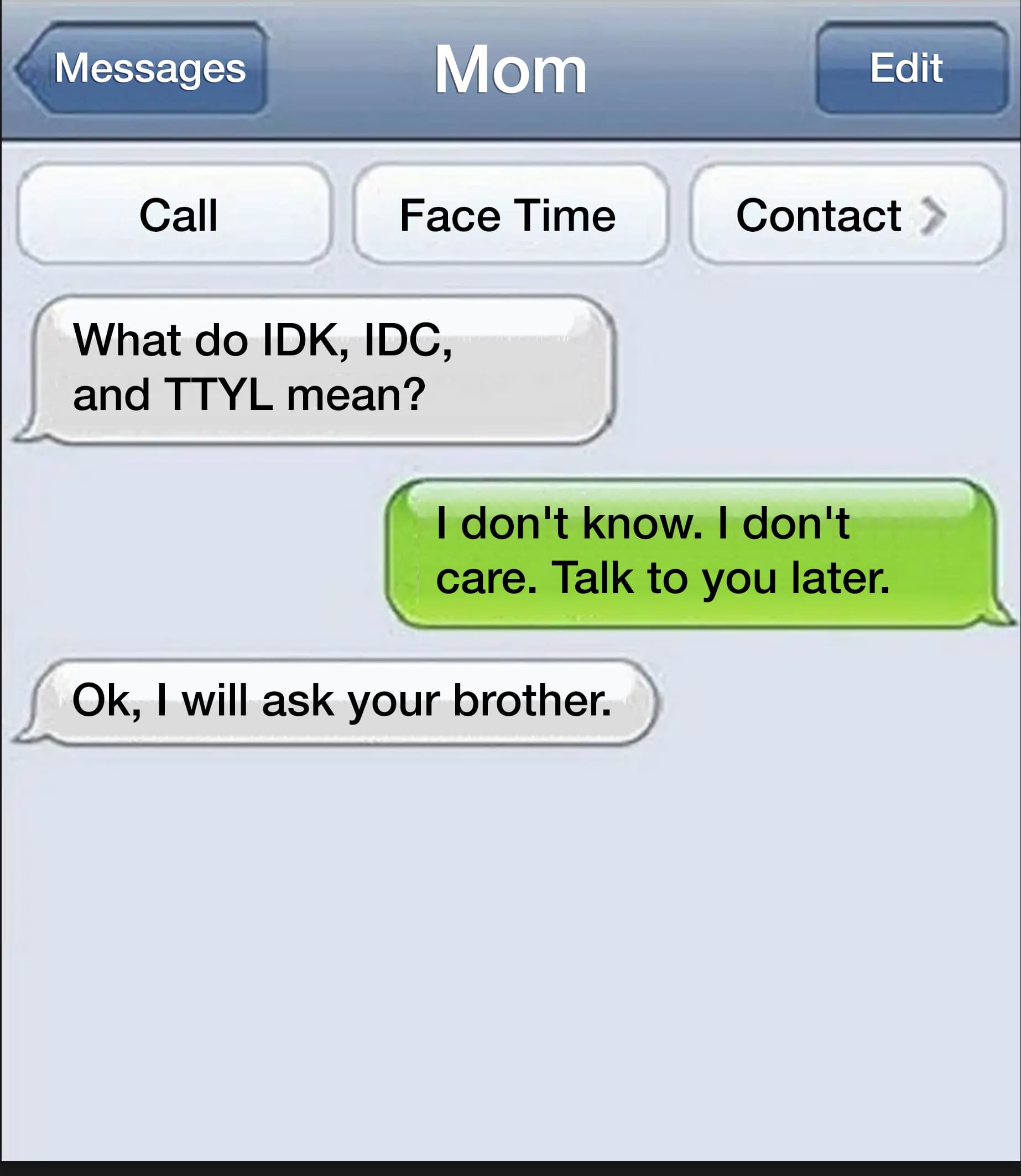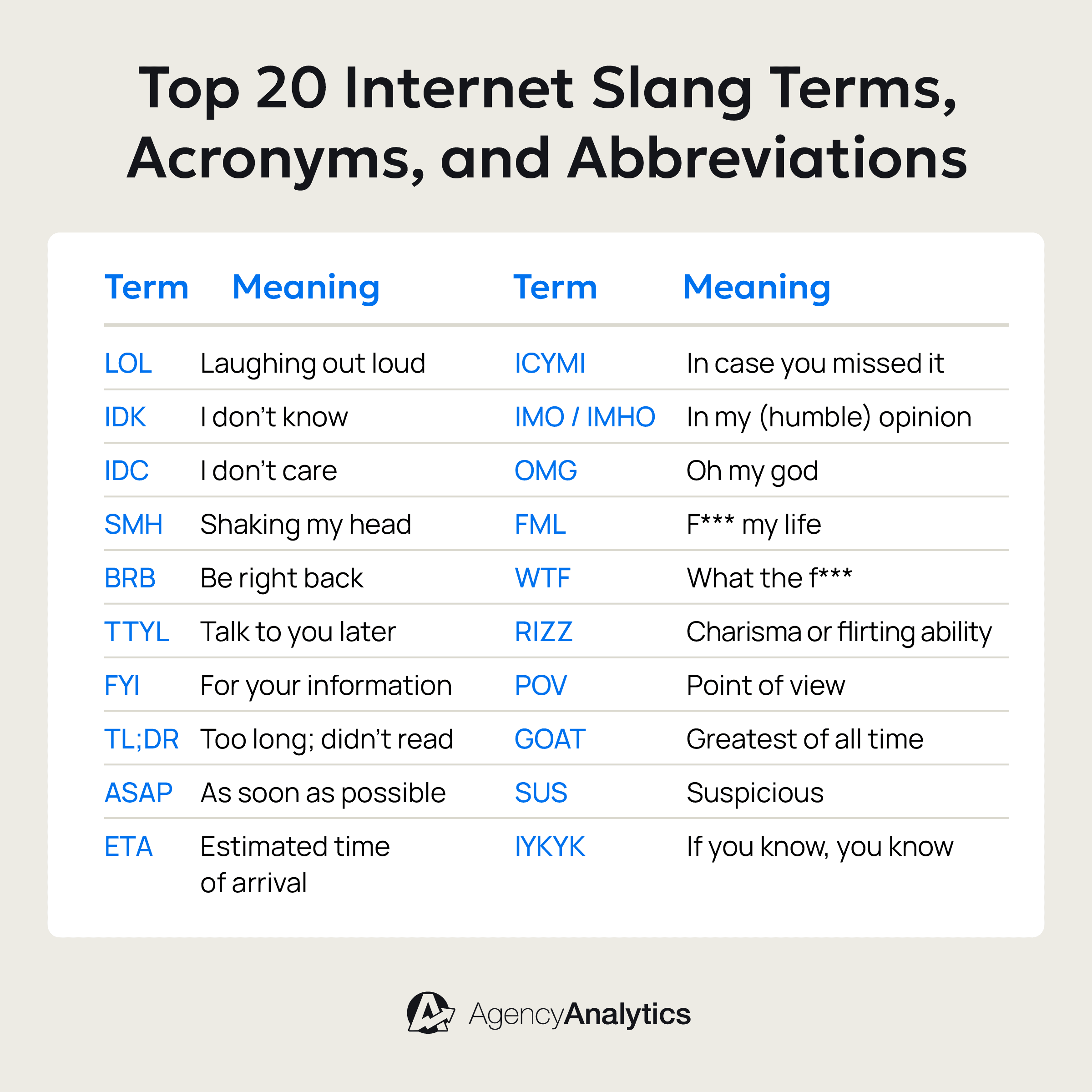Table of Contents
QUICK SUMMARY:
Wondering what IDC, FYP, or ROFL actually mean? This guide breaks down the most common internet slang terms, acronyms, and text abbreviations—with examples, context, and a few that might surprise you.
Internet slang moves fast. Even seasoned scrollers can find themselves asking, “Wait… what does that mean?”
What started as simple shorthand on early chat platforms and SMS—things like BRB or LOL—has evolved into a full-blown language of its own. Today, acronyms, abbreviations, and slang shape how we communicate across texts, memes, group chats, and social media.
Some terms are self-explanatory. Others? Not so much. (Looking at you, “NPC.”)
Whether you're messaging with coworkers, replying to a group chat, or trying to understand what your client meant when they typed “IYKYK,” knowing internet slang isn’t just useful—it’s how we stay connected.
It helps you navigate digital conversations, avoid misunderstandings, and maybe even get a laugh or two.
Before emojis, voice notes, or even GIFs, the internet ran on text. And when you're typing everything—especially on early platforms like Internet Relay Chat or SMS (short message service)—every character counts.

That’s where abbreviations and acronyms came in.
They started as a practical solution. When character limits were tight and typing took time, acronyms saved effort. “BRB” let someone know you’d be back. “LOL” meant you were joking or appreciated a joke.

Fast forward to today, and things have only sped up.
Social media, texting, and online games have created a culture where quick, punchy messages dominate. Instead of writing whole paragraphs, people communicate with acronyms, initialisms, or phrases that carry layers of meaning—especially when tone and body language don’t translate onscreen.
Internet slang also adds a sense of play. Saying “I can’t with this” or “SMH” expresses emotion without overexplaining. And terms like “IRL” (in real life), “POV” (point of view), or even “TMI” (too much information)—help convey complex ideas in just a few keystrokes.
This kind of language is fluid. What’s trending on TikTok might confuse someone reading emails at work. But that’s part of its charm: slang signals a sense of belonging. It reflects the platforms we use, the jokes we share, and the communities we move through online.
So, whether you're texting your best friends, drafting a message to accompany a client report, sending a private message, or skimming social media comments, internet slang is how we make digital conversations feel a little more human.
Abbreviations and acronyms in digital communication
Even though we often use terms like acronym, abbreviation, and slang interchangeably, they’re not quite the same. Understanding the difference helps decode what you’re seeing—and why it exists in the first place.
Let’s break it down.
Term | What it means | Example |
|---|---|---|
Acronym | A series of initials that form a new word or expression | SCUBA = Self-contained underwater breathing apparatus |
Initialism | Often used interchangeably with the word acronym, an initialism is different because it’s pronounced letter by letter.
| LOL = Laughing Out Loud |
Abbreviation | A shortened version of a word or phrase | SUS = Suspicious |
Internet slang | Informal or playful language created by online communities | yeet, ghosted |
Each of these forms of language evolved to solve a specific problem—whether that was saving space in a single message, typing faster on a keyboard (or keypad), or expressing tone in the absence of facial expressions and vocal cues.
Some terms come from professional contexts. Others were born in gaming, forums, or early instant messaging services. And many—especially those rooted in texting or social media—spread because they were easy to copy, remix, and adapt.
In a way, internet language has always been crowdsourced. That’s why you’ll find different slang and abbreviations popping up in other spaces—from chat rooms to YouTube comments to group chats at work.
However, no matter where they appear, abbreviations and acronyms are now an integral part of online communication.
Popular internet slang words and acronyms (and what they mean)
Internet slang changes fast—but some terms have become essential. To keep things manageable, we’ve grouped them by category—starting with the ones you’ll probably see most often on social media and in your text messages.
Social media slang
These are the acronyms and phrases that dominate platforms like Instagram, TikTok, Snapchat, and X (or Twitter, if you still prefer that). Many of them show up in captions, replies, hashtags, or direct messages.
Term | Meaning | Example Use |
|---|---|---|
DM | Direct message | “Send me a DM if you have questions.” |
FYP | For You Page (TikTok’s algorithmic feed) | “This video better end up on everyone’s FYP.” |
OOTD | Outfit of the day | “Here’s my #OOTD—comfy but cute.” |
POV | Point of view | “POV: You just realized it’s Monday again.” |
TBH | To be honest | “TBH, I wasn’t expecting that plot twist.” |
ILY | I love you | “Goodnight! ILY 🩵” |
BFF | Best friends forever | “Just two BFFs causing chaos.” |
These phrases help make posts feel more casual, personal, and relatable. They also allow people to share reactions, opinions, and context—without needing a lengthy caption or complete sentence.
Emotional expressions and reactions
Tone can be hard to read online. That’s why slang that shows emotion—especially humor, frustration, or sarcasm—spreads quickly. These abbreviations help people react in real time, whether they’re laughing at a joke, rolling their eyes, or expressing total disbelief.
Term | Meaning | Example Use |
|---|---|---|
LOL | Laughing out loud | “That joke was so bad I actually LOL’d.” |
LMAO | Laughing my a** off | “LMAO, that’s the best fail I’ve seen all day.” One step above LOL |
ROFL | Rolling on the floor laughing | “ROFL at this entire thread 😂” Just above LMAO, but slightly below ROFLMAO. |
SMH | Shaking my head | “The client wants the creative by tomorrow! SMH.” |
TMI | Too much information | “Okay, wow—TMI, but go on.” |
IDC | I don’t care | “IDC what you think.” |
OMG | Oh my god | “OMG, did you see her reaction to the new custom marketing dashboard?” |
WTF | What the f*** | “WTF is going on with Looker Studio?!” |
FML | F*** my life | “Spilled coffee on my white shirt right before a meeting. FML.” |
FFS | For f***’s sake | “The Excel formulas broke again. FFS.” |
IDGAF | I don’t give a f*** | “IDGAF if it’s 3 AM, I’m getting tacos.” |
Together, these help people express real emotion with just a few characters—especially when tone might get lost in translation.
Work & productivity terms
Not all internet slang is casual. In work chats, emails, or project threads, acronyms are often used to keep communication efficient—especially when everyone’s juggling deadlines, messages, and meetings. These terms help establish expectations, clarify timelines, and facilitate progress.
Term | Meaning | Example Use |
|---|---|---|
OOO | Out of office | “Just a heads-up—I’ll be OOO next week.” |
EOD | End of day | “Can you send the draft by EOD?” |
COB | Close of business | “Let’s aim to finalize this by COB.” |
TL;DR | Too long; didn’t read | “TL;DR: The Client loved the social media proposal.” |
FYI | For your information | “FYI: The schedule’s been updated.” |
AFAIK | As far as I know. | “AFAIK, the campaign launches Thursday.” |
ASAP | As soon as possible | “Need those campaign assets ASAP.” |
ETA | Estimated time of arrival | “What’s the ETA on the new pitch deck?” |
PTO | Paid Time Off | “I’ll be on PTO next Friday.” |
NRN | No reply necessary | “Manual reporting is eating our souls.—NRN.” |
ICYMI | In case you missed it | “ICYMI, here’s the new pricing rollout.” |
TBD | To be determined | “Budget split is still TBD.” |
These terms are especially common in internal tools like Slack or Microsoft Teams, as well as in short emails and status updates. They help cut down on message clutter while still keeping things clear—and they’re widely recognized across various industries.
Gaming, Gen Z, and online subculture slang
A lot of today’s slang starts in very specific corners of the internet—like gaming chat, Twitch streams, or TikTok comments—and then makes its way into everyday use. These terms might sound confusing at first, but once you know them, they’re everywhere.
Term | Meaning | Example Use |
|---|---|---|
GG | Good game | “Tough loss, but GG everyone.” |
AFK | Away from keyboard | “BRB—AFK for 10 mins.” |
NPC | Non-player character; slang for someone who seems unoriginal or unaware | “He just stood there like an NPC.” |
GOAT | Greatest of all time | “Serena Williams = the GOAT.” |
SUS | Suspicious | “That excuse sounds kinda sus.” |
IYKYK | If you know, you know (an inside joke or reference) | “When you get a crazy client request at 4:30 p.m. on Friday... IYKYK.” |
BFFR | Be f***ing for real | “BFFR—you're not wearing that to brunch.” |
FR | For real | “We built the whole client report in under 30 minutes. FR.” |
RIZZ | Charisma, flirting skill | “He’s got major rizz—everyone’s into him.” |
DEAD | Used to express laughter or disbelief | “Client asked if we could ‘just pull all the data manually again.’ DEAD.” |
If you’re trying to decode a comment that sounds like a whole new language, there’s a good chance it came from this world.
Text message abbreviations
Many of these abbreviations have been around since the early days of texting and short message service (SMS). They were designed for speed, and even though full keyboards and voice-to-text features exist now, many of these terms still appear in group chats, private messages, and day-to-day texting.
Term | Meaning | Example Use |
|---|---|---|
TTYL | Talk to you later | “Gotta run—TTYL!” |
GTG / G2G | Got to go | “Dinner’s ready, GTG.” |
IDK | I don’t know | “IDK what to wear tonight.” |
MYOB | Mind your own business | “To avoid drama, best to MYOB.” |
XOXO | Hugs and kisses | “Happy birthday! XOXO 💕” |
These terms often overlap with slang used on social media and in online chats. They're part of a shared language that’s quick, expressive, and—despite evolving platforms—still very much alive in texting culture.
Number-based text slang you might still see
Before emojis and full keyboards, people got creative with numbers. While most of these aren’t used daily anymore, they still pop up from time to time in texts, old forum posts, or teen slang. And let’s be honest—decoding them is half the fun.
Number | Meaning | Explanation |
|---|---|---|
143 | I love you | Based on letter count: 1 (I), 4 (love), 3 (you) |
831 | I love you | “8 letters, 3 words, 1 meaning” |
823 | Thinking of you | Used to express care or affection |
182 | I hate you | Sometimes used jokingly—reverse of 143, but related to the sounds (8 = hate, 2 = you), not the letters. |
459 | I love you | Pager-era variation of 143 |
637 | Always and forever | Popularized in early texting culture |
If you ever receive a random number string in a message, chances are it’s either a typo or someone’s trying to throw it back to the pager generation. Either way, now you’ll know what it means.
Legacy and chatroom terms
Before TikTok, Instagram, or even Facebook, internet slang thrived in spaces like IRC (Internet Relay Chat), message boards, and early IM platforms like AIM and MSN Messenger. Many of these terms still pop up today—especially in tech circles, gaming communities, or as playful throwbacks.
Term | Meaning | Example Use |
|---|---|---|
PM | Private message, the old-school version of DM | “I'll send you the details via PM.” |
FAQ | Frequently asked question, now more of a website schema item than a social media message. | “Check the FAQ before asking—it's all in there.” |
RTFM | Read the f***ing manual (a snarky reply to basic questions) | “Having trouble setting it up? RTFM.” |
A/S/L | Age / Sex / Location | “A/S/L was the original small talk.” |
BRB | Be right back | “Dinner’s here—BRB.” |
IMO / IMHO | In my (humble) opinion | “IMHO, the update made things worse.” |
IMNSHO | In My Not So Humble Opinion | “That Looker Studio report is a complete mess, IMNSHO.” |
BBS | Be back soon, like BRB, but indicating a slower return | “Heading to class—BBS.” |
SNAFU | Situation normal, all f*ed up | “Client reporting week with no reporting automation? Classic SNAFU.” |
TTFN | Ta-ta for now | “Gotta log off—TTFN!” |
Some of these might feel old-school, but they paved the way for the language we use today. And if you’ve spent any time in niche online communities—or messaging with someone who’s been online since the ‘90s (like me)—you’ll still see them from time to time.
How to decode new internet slang
The one constant about internet slang? It never stops evolving.
Just when you think you’ve got a handle on all the acronyms and text abbreviations floating around, a new one pops up—and suddenly everyone’s using it like it’s common knowledge.
Here’s the good news: decoding new slang isn’t about memorizing every term. It’s about understanding how this type of language works and where it originates.
Start with context
Most internet slang doesn’t come with instructions, but it does come with clues. Look at how it’s being used in a sentence, the tone of the conversation, and who’s saying it. Is it a private message from your best friend? A comment under a meme? A reply in a Slack thread?
Even unfamiliar shorthand can become clear once you see it in action. Think of it as learning a new dialect—not a whole new language.
Know where slang spreads
Internet slang often originates in specific online spaces, such as TikTok comments, gaming chats, X (formerly Twitter) threads, Reddit posts, or even Discord servers. And then there’s the old-school stuff—like PIR (parent in room) or KFY (kiss for you)—that’s straight out of the early AIM and SMS era. If your teenage years included sneaking in late-night chats on a Nokia phone, you probably remember those.
Use tools—just not that one
If a new acronym pops up and you’re completely lost, go ahead and search it. Sites like Urban Dictionary, Know Your Meme, or even a quick Google search will usually point you in the right direction. (Just maybe don’t search “RIZZ meaning” in front of your coworkers.)
And of course, you can always ask ChatGPT. I’ve seen people drop acronyms in there with messages like:
“WTF does this mean: ‘idc lol fr smh’—pls decode like I’m 40.”
Trust me, I get it.
Not all slang is safe to use
Some internet acronyms started as in-jokes or edgy expressions and haven’t aged well. Others began as derogatory terms and were later reclaimed by specific communities. So if you’re not sure what something means—or if it feels off—it’s totally fine to ask or skip using it altogether.
There’s no cheat sheet for slang that works in every situation (or every inbox). It depends on your audience. What’s totally fine in DMs or emails between close friends might be entirely off-brand in a work message to your boss.
Slang isn’t just fun—it’s human
At its best, internet slang isn’t about being cool or current. It’s about speed, connection, and tone. It adds humor. It softens a direct message. It makes short conversations feel more genuine.
Even if you don’t want to use all the latest acronyms, understanding them helps you meet others where they are—whether they’re your coworkers, clients, or kids.
And in my humble opinion? That’s worth keeping up with.
TL;DR - A top 20 cheat sheet of the most commonly used internet slang terms, acronyms, and abbreviations
Here’s a quick list of 20 of the most widely used internet terms—spanning social media slang, workplace acronyms, and texting shorthand. These are the ones you’re most likely to see across platforms, DMs, and comment sections.

Impress clients and save hours with custom, automated reporting.
Join 7,000+ agencies that create reports in under 30 minutes per client using AgencyAnalytics. Get started for free. No credit card required.
FAQs about common internet acronyms, slang terms, and abbreviations
Still wondering what half the internet is saying? Below are answers to some of the most commonly searched questions about internet slang.
It depends on your tone and audience. Abbreviations like TL;DR, FYI, or ETA are standard in professional settings. More casual slang—like LOL or BRB—might be fine in internal chats but could feel out of place in formal emails or client-facing communication.
When in doubt, keep it clear. If the slang softens your tone or adds a human touch, go for it. If it might confuse or distract, skip it.
Because internet slang evolves like language (in fast-forward). As phrases spread across platforms and subcultures, people remix them—either for emphasis, humor, or just to make them feel more personal.
Take the classic LOL (laughing out loud). It’s been around for decades, but that hasn’t stopped new versions from popping up:
LMAO – Laughing my a** off
ROFL – Rolling on the floor laughing
ROFLMAO – A combination of both
LOLOL, LOLZ, or just 😭 — a modern emoji that now often means 'I’m laughing so hard I’m crying.'"
Each version reflects a slightly different tone—from casual laughter to over-the-top amusement. People choose the variation that best fits the moment—or their sense of humor.
But, no, LOL does NOT equal "Lots of Love".
You’ll also see layered meanings in opinion-based slang:
IMO – In my opinion
IMHO – In my humble opinion
IMNSHO – In my not so humble opinion
IMHO (alternate use) – In my honest opinion
These subtle tweaks help express attitude, tone, or even sarcasm—especially when facial expressions and voice aren’t part of the conversation.
It’s part of what makes internet slang feel so alive. It’s not fixed. It flexes based on who’s using it, where they are, and how they want to be understood.
Absolutely. Internet slang is as much about tone as it is about text—which means the same phrase can feel totally different depending on who says it, how it's said, and where it shows up.
Take IDC (I don’t care), for example:
In a chill group chat, it might mean: “Meh, I don’t mind—whatever works for you.”
But in an argument? It could come off as: “I DON’T CARE. Leave me alone.”
Since most slang skips punctuation and tone indicators, a lot gets left to interpretation. That’s why context matters—the platform, the relationship, and even the emoji next to the message can shift how a phrase feels.

Written by
Paul Stainton is a digital marketing leader with extensive experience creating brand value through digital transformation, eCommerce strategies, brand strategy, and go-to-market execution.
Read more posts by Paul StaintonSee how 7,000+ marketing agencies help clients win
Free 14-day trial. No credit card required.






